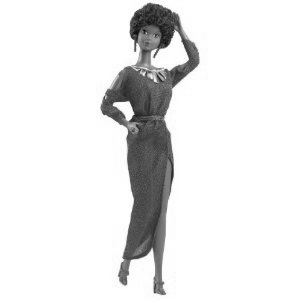 We are no fans of Barbie here on Eco Child’s Play. From greenwashing to negatively affecting girls’ body image, almost no little girl in America grows up without this plastic doll.
We are no fans of Barbie here on Eco Child’s Play. From greenwashing to negatively affecting girls’ body image, almost no little girl in America grows up without this plastic doll.
She comes in many shades and styles now (and we all know Ken was gay). I recently came across a post on Teaching Tolerance that reminded me of my own childhood experience with the Black Barbie Doll.
Black Barbie was introduced in 1980. I was nine-years-old then, and the trip to the toy store for this doll is memorable for many reasons. My sister and I were so excited to get the doll. We drove in my mom’s MGB with the top down. Unfortunately, on the way home (dolls in hand), we were involved in a serious car accident. No one was hurt, as I recall. I think our Black Barbies survived.
Why did my parents feel the need to get us Black Barbies? Was it because it was the newest Barbie, and we had to have it? Or was it an effort to bring some multiculturalism into our white suburban middle class upbringing?
H. Roy Kaplan, who teaches African American studies at the University of South Florida, shared this personal story about the African American doll:
Leslie, a 38-year-old social worker who counsels children with stressful life situations, found her 4-year-old daughter, Sophia, engaged in animated play with her dolls. She watched incredulously as Sophia invited the four white dolls with blonde hair to a tea party while the dark-skinned doll with black hair lay alone across the room.
“Why isn’t that doll going to the tea party?” she inquired.
“She’s dead,” replied Sophia matter-of-factly.
“Dead? How can that be? She’s just like the other dolls. Why can’t she play with them?”
“They don’t want to play with her.”
“Why is that?”
“Because she has dark skin,” replied Sophia.
Leslie’s mouth dropped to the floor as she fought back tears. How could this be? Hadn’t she and her husband worked diligently to teach her child to be inclusive? Sophia had a variety of multicultural toys and books. She was only allowed to watch progressive television shows like Sesame Street, Dora the Explorer, Diego, theBackyardigans and Yo Gabba Gabba. An only child, she attended an expensive, supposedly inclusive pre-kindergarten school which included children of color.
“Sweet Pea,” said Leslie, plaintively, “you’re hurting that doll’s feelings. You’ve got to let her play with the other dolls.”
“She can’t. She’s in jail,” Sophia replied as she rationalized her decision to exclude the dark-skinned doll.
This scenario has probably been repeated in countless homes and classrooms around the country. But it was a real situation that wrenched Leslie and me, as we tried to come to a resolution to the problem. You see, Sophia is my granddaughter, and I happened to be visiting when this incident occurred. As an advocate for civil rights and a diversity trainer, the family looked to me for an answer.
I don’t know if I ever played out any racist scenarios with my own Black Barbie. I don’t remember. I think she was too cool to be excluded, as she was new. Kaplan’s story is a good reminder that even good intentions often go awry and promote racial stereotypes.
I think the move towards representing different cultures with dolls or Disney princesses is well-intended, but if the dolls don’t accompany real experiences, as Kaplan later suggest, then it is a token gesture. It’s sort of like the holiday approach to multicultural education found in most schools. Reading about Kwanzaa or celebrating Chinese New Year is superficial. Simply changing the color of a doll’s or princess’ skin without changing other features is again, superficial.
In an article about Wal*Mart selling darker skinned Barbies for cheaper, ABC News reported last year:
But Sociological Images co-author Gwen Sharp, a sociology professor at Nevada State College, said that inequality might not necessarily be what’s behind Ballerina Theresa’s lagging sales.
Black parents, she said, may simply choose black dolls whose physical features hew more closely to those of themselves and their children. Barbie has weathered critcism in the past for producing dolls that bear little resemblance to the ethnicities they represent.
“Maybe for both parents and kids, it seems more real and less symbolic of a change to have a doll that actually presents a range of attractive features rather than ‘Oh we’ve changed the skin tone slightly,'” Sharp said.
Apparently Barbie So In Style dolls do reflect more accurately African Americans, but I find their names to be stereotypical. The dolls still misrepresent an accurate image of a woman’s physique, no matter the race.
My daughter does have dolls that reflect other cultures, such as from Inca Kids. She may only know one real Peruvian, but at least she is not playing with plastic, out of proportion, junky dolls. At least not anymore 🙂
Leave a Reply